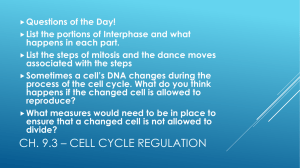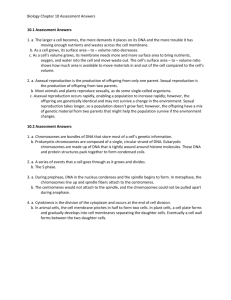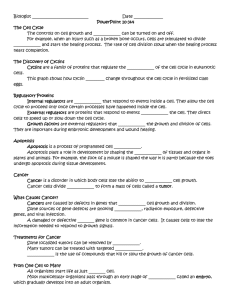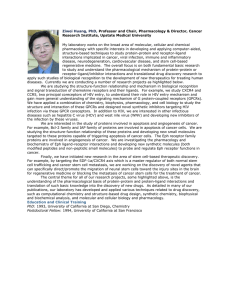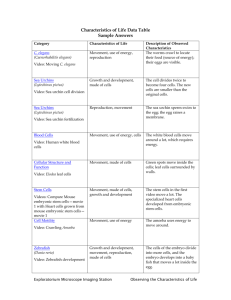Cell Cycle Regulation: Cyclins, Cancer, and Stem Cells
advertisement
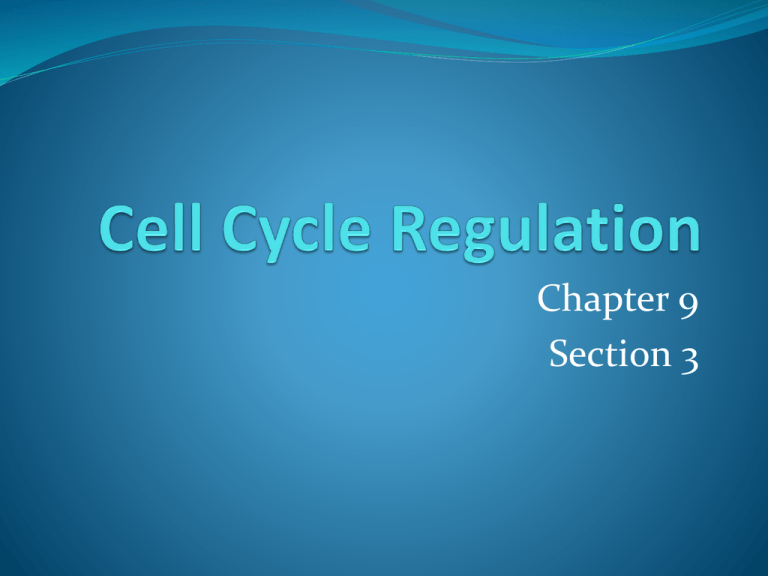
Chapter 9 Section 3 Main Idea The normal cell cycle is regulated by cyclin proteins Normal Cell Cycle To start the cell cycle in eukaryotic cells is driven by a combination of two substances that signal the cellular reproduction processes Proteins called CYCLINS bind to enzymes called CYCLIN-DEPENDENT KINASES (CDKs) Different cyclins and CDK combinations control different activities at different stages in the cell cycle Quality control Checkpoints The cell cycle also has built in checkpoints to monitor the cycle and can stop it if something goes wrong At the end of G1 stage a checkpoint monitors for DNA damage and can stop the cycle before entering the S stage of interphase Abnormal Cell Cycle: CANCER Although the cell cycle has a system of checkpoints, these checkpoints sometimes fail When cells do not respond to the normal cell cycle control mechanisms, a condition called cancer can result CANCER is the UNCONTROLLED GROWTH and DIVISION OF CELLS Cancer cells grow and divide unrestrained as long as they are supplied with essential nutrients Causes of Cancer Cancer can occur in many healthy, active and young organisms The changes that occur in the regulation of cell growth and division of cancer cells are due to mutations or changes in the segments of DNA that control the production of proteins, including the Cyclins that control the cell cycle Carcinogens are substances and agents that are known to cause cancer Examples of Carcinogens Tobacco Second hand smoke Asbestos Ultraviolet radiation (sunlight) X-rays Cancer Genetics More than one change in DNA is required to change an abnormal cell into a cancer cell Since multiple changes must occur this might explain why cancer runs in some families an individual who inherits one or more changes from a parent is at a higher risk of developing cancer than someone who does not Apoptosis Not every cell is destined to survive APOPTOSIS is PROGRAMMED CELL DEATH For example: when the human hand and foot are developing, the cells between the fingers and toes goes through apoptosis Stem Cells Are unspecialized cells that can develop into specialized cells when under the right conditions There are two types of Stem cells: embryonic and adult Embryonic Stem Cell After a sperm fertilizes an egg, the result is a mass of cell divides repeatedly until there are about 100-150 cells If separated, each of these cells has the capability of developing into a wide variety of specialized cells Embryonic stem cell research is controversial because of ethical concerns about the source of the cells Adult Stem Cells Are found in various tissues in the body and might be used to maintain and repair the same kind of tissue in which they are found An example of use for adult stem cells: researchers used pancreatic stem cells to restore pancreas function in a mouse with diabetes Adult stem cells is much less controversial because the adult stem cells can be obtained with the consent of their donors
